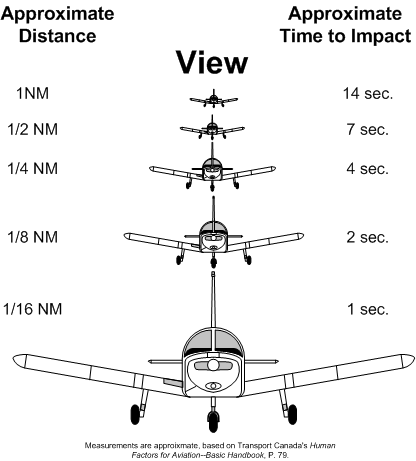Empty-field Myopia
Two aeroplanes, a Piper and a Cessna, were flying straight and level on a cross-country flight at an altitude of 1500’ AGL. Neither aeroplane was under radar contact. Visibility conditions were seven miles in haze. The two aeroplanes collided almost directly head-on. There were no survivors.
Analysis:
- The haze conditions produced empty-field myopia in both pilots’ eyes. Therefore, each aeroplane appeared smaller and more distant than it actually was. With limited visibility, the danger did not become apparent until it was too late for evasive action.
- Since the frontal area of the aeroplane profile is small, an aeroplane viewed directly from the front shows little relative movement. Hence, detection by either pilot was difficult (Transport Canada’s Human Factors For Aviation—Basic Handbook, Pp. 77-78)
A pilot who experiences empty-field myopia is a pilot who is unable to see an aircraft in the distance, despite the unrestricted visibility.
To see something, the lens of the eye must be capable of physically focusing light from the object on the retina. To do this, the eye must be stimulated by an image. If the eye lacks this stimulation, the lens shifts to a resting state some three to five feet away.
When the sky is featureless—as is the case with unrestricted visibility, with hazy conditions, or dark night conditions—you effectively become near-sighted when you look out the windows as your eyes tend to resort to their natural resting state.
To counter empty-field myopia, it is a good practice to focus quite frequently on your own aircraft wing tips. Also, when scanning, focus on distant visible objects or outlines at or near the horizon, stimulating the eyes to establish long-distance focal points.
Consider that a target (another aircraft) on a collision course appears fixed and increasing in size to the observer. Changes in size are difficult to perceive, so a pilot who observes any fixed target should first immediately alter course, then assess its direction.

.jpg)

